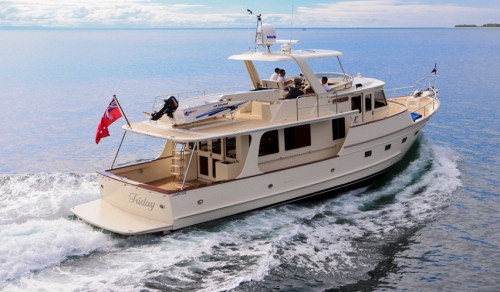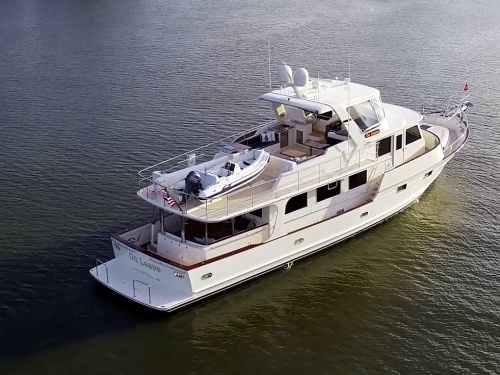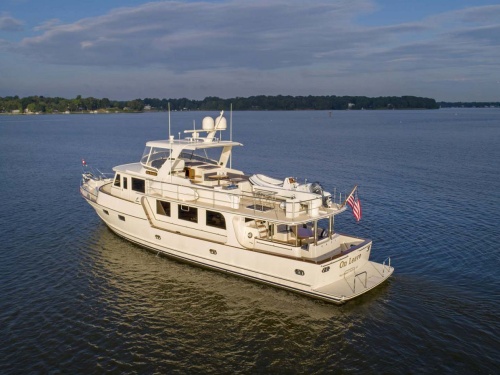Access More Boat Tests
Already have an account? Login
Fleming Yachts 55 (2018-)
2 x 500-hp Cummins QSC 8.3
Brief Summary
The Fleming 55 is now well over 30 years old and shows no sign of aging — that’s longer than the venerable Bertram 31 was in production! Why does this vessel have so much longevity and show no signs of getting tired? The big reason is that many boaters consider her to be as drop-dead gorgeous today as when she was first launched in 1986. Then, she can do most anything, from sailing across the Atlantic to hosting a large cocktail party, or coastal cruising with friends in comfort. Her interior is lavished in teak and her layout is as practical as they come. But there is much more to the secret of this motoryacht’s success.
We recently tested the Fleming 55 off Sydney, Australia, and following is a full Captain’s Report on what we discovered.
Key Features
- Cockpit with teak decks
- Engine room air intakes behind skirt and inside bulwarks
- Ritchie Compass with light & dimmer
- Flybridge table starboard side with drink holders
- FRP Radar arch with LED lighting
- Two Mastervolt 24v to 12v DC-DC converters with 12v battery back-up system
- Salon entertainment center, teak cabinetry, and full length lockers from galley to aft bulkhead
- Forward stateroom tapered queen-sized bed with hydraulic lift and manual slide mechanism
Test Results
| RPM | MPH | Knots | GPH | MPG | NMPG | STAT. MILE | NM | dBa |
|---|---|---|---|---|---|---|---|---|
| 700 | 6.1 | 5.3 | 1.5 | 4.1 | 3.5 | 3660 | 3182.6 | 60 |
| 1000 | 8.6 | 7.4 | 2.4 | 3.6 | 3.1 | 3206 | 2788 | 59 |
| 1233 | 10 | 8.7 | 5.3 | 1.9 | 1.6 | 1690 | 1469.2 | 60 |
| 1250 | 10.1 | 8.7 | 5.3 | 1.9 | 1.6 | 1707 | 1484 | 61 |
| 1460 | 11.2 | 9.7 | 7.9 | 1.4 | 1.2 | 1270 | 1104.6 | 62 |
| 1500 | 11.5 | 10 | 8.5 | 1.3 | 1.2 | 1212 | 1054.2 | 65 |
| 1550 | 11.7 | 10.1 | 10.6 | 1.1 | 1 | 989 | 860.1 | 66 |
| 1750 | 12.6 | 10.9 | 15.6 | 0.8 | 0.7 | 724 | 629.6 | 64 |
| 2000 | 14 | 12.2 | 25.4 | 0.6 | 0.5 | 497 | 432.2 | 69 |
| 2250 | 16 | 13.9 | 34 | 0.5 | 0.4 | 424 | 368.8 | 71 |
| 2500 | 19.3 | 16.8 | 44.4 | 0.4 | 0.4 | 392 | 340.6 | 71 |
| 2640 | 20.9 | 18.2 | 49.9 | 0.4 | 0.4 | 377 | 327.8 | 71 |

Specifications
| Length Overall |
60' 9" 18.5 m |
|---|---|
| Beam |
16' 4.88 m |
| Dry Weight |
67,801 lbs. 30,754 kg |
| Draft |
5' 1.52 m |
| Max Headroom |
6' 6" 1.97 m |
| Fuel Capacity |
1,000 gal. 3,785 L |
| Water Capacity |
300 gal. 1,135 L |
Acceleration Times & Conditions
| Props | 31d x 30p 4 blades |
|---|---|
| Load | 5 persons, 1/4 fuel, 5/8 water, 50 lbs. of gear |
| Climate | 73.8 deg., seas: calm |
Engine Options
| Tested Engine |
2 x 500-hp Cummins QSC 8.3 |
|---|---|
| Std. Power |
2 x 500-hp Cummins QSC 8.3 |
 Learn More
Learn More
Watch Our Video
Contents of Report
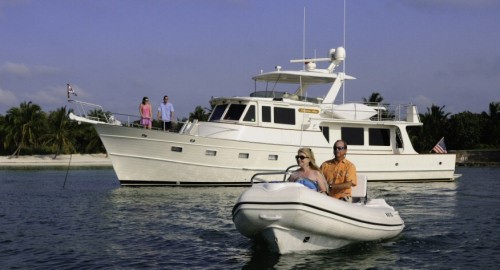
The Mission of the Fleming 55
The Fleming 55 is designed for a cruising couple, or two couples, or even a family to make long offshore and coastal passages in comfort and safety. And that means to be able to travel to the Caribbean, or to the Pacific at trawler speeds. At 7.4 knots, we found that she has a range of 2,788 nautical miles. That means she can make it from Bermuda to the Azores on a transatlantic trip, or from Southern California to the Hawaiian Islands, then go south into French Polynesia.
But there is another side to the Fleming 55: because she is powered by twin 500-hp diesels she can get on plane and hit 18 knots or so in a pinch, when outrunning a storm, or getting to a tricky anchorage by nightfall. And because she has such large spaces in her salon, aft deck, and on her flying bridge, she is an able motoryacht for entertaining a large party. In all ways, the Fleming 55 is a purposeful motoryacht and one that has the look that launched a dozen imitations.
The Fleming 55 is the original. But little about her is like she was 31 years ago, except her exterior and her lavish use of teak inside.
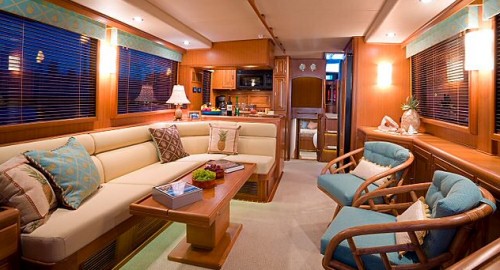
Is She a Trawler or a Motoryacht?
Most boaters immediately categorized her as a "trawler" because of the shape of her bow, faux planks, and Portuguese bridge. Further, she does not have the trappings of most modern motoryachts that we see – things like a table on the bow, a low-raked windshield like that of a Lamborghini, or large windows which have been cut into her hull sides with unusual shapes.
But on the other hand, she has virtually every modern convenience as a multi-million-dollar gin palace, and a number that they don’t have.
Classic Look
To a great degree, motoryachts inside are very much the same in layout. They may be a pilothouse version or a flushdeck, but the layouts of virtually all are the same in any given size range. Where the Fleming 55 sets herself apart becomes immediately obvious when looking inside — she is practical with radiused corners on the joinery, large windows, and a salon for living in as well as for entertaining.
Her lavish use of teak is somehow both unpretentious yet sophisticated, and it certainly harkens back to the halcyon days of yachting at its finest in the early part of the 20th century. Her interior décor can only be described as traditional, classic, and tasteful.

Her Profile
Undoubtedly her most distinguishing feature is her profile, with high flared bow, raked stem, molded-in faux planking, her raised pilothouse and Portuguese bridge. This look makes the heart race among serious cruising folk. Maybe that is why it has been so widely copied — but rarely matched. We are told by the builder that her exterior is the single most important reason why owners are attracted to her, but during our inspection we found some other reasons, as well.
Large Lower Helm
In her raised pilothouse, the helm stretches all the way from the door on the port side to the chart table by the starboard door. In between is enough room for as many screens, gauges, electronics, and instruments as any electronics buff could want. (We have actually been on commercial vessels with far fewer instruments than can be put on this boat and often are.) But, that is an owners’ preference. Fleming prefers to keep things simple and on our test boat, there were only two navigation screens, both of which could display all manner of electronic input.

Böning/Fleming Monitoring System
The centerpiece of the Fleming 55 helm is its remarkable system of boat monitoring. It is the most sophisticated and all-encompassing monitoring system we have seen on a recreational motoryacht of this size, and it is used mainly on megayachts in addition to commercial vessels.
More than 10 years ago Fleming worked with the engineers at Böning to create a system that was specially adapted to its boats and the kind of boating, and information, its owners needed.
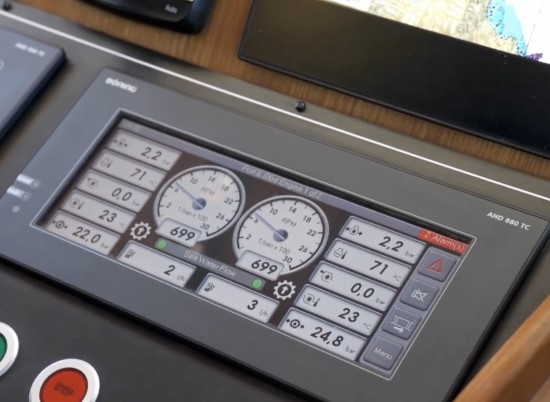
Essentially, the Böning system monitors all of the vital signs of the boat, her engines, and her critical equipment. It monitors everything that dozens of conventional gauges, readouts and dials do on many motoryachts — and many things that are not generally monitored. It has all of the information displayed on one of two 15” screens below, and on an 8.8” (22 cm) screen at the upper helm.
The software devotes different screen pages to various aspects of the boat. All data points are recorded on a hard drive and can be viewed, or sent via the Internet to an outside location, and can be helpful for service professionals to view and diagnose problems.
One of the most useful features is a checklist of things that must be ready for the vessel to go to sea, much like the checklist used by commercial pilots.
Early Warning
We think of the Böning system as a sort of early warning system for detecting potential trouble on the dozens of systems on the boat, before it gets out of hand. For example, it can sense problems such as dropping raw-water-intake pressure before engine temperatures start to spike. Owners can set alarms for fuel and water tank levels as well as oil level and pressure to notify them when certain programmed levels are reached.
A short list of just some of the things that it senses and reports on include: the engines, the generator, bilge and sump pumps, Seatorque shaft oil temperature, freshwater pressure and flow, doors and hatches open or closed, main engine seawater flow, and watermaker (if installed), among many other things, including the following list:
- Engine data
- Gear oil data
- Navigation lights
- Bilge pumps
- Pilothouse defoggers
- Fuel tank levels
- Water tank levels
- Engine raw water flow
- Generator monitoring
- Shore power
- Exterior lighting
- Engine room blowers
- High water alarms
Most important, it can monitor virtually everything in the engine room, and it, along with a TV camera and FLIR infrared camera, can give peace of mind to a captain who is short-handed. While the system does not make trips to the engine room superfluous, it can certainly reduce the frequency of visits. Since the headroom in the engine room is just 4’4” (1.32 m), it makes fewer trips there welcome.
Construction Details
The Fleming 55 is built to CE Classification A standards, which means she should be able to handle anything short of a named storm.
Bow Shape
The bow of the Fleming 55 has a sharp entry which enables her to slice through waves comfortably rather than pound into them. There is no chine forward, which eliminates that sleep-hindering slap when at anchor. Of course, the lack of the forward chine means there’s no spray knocker, and the boat can be a bit wet at higher speeds.

5 Coats of Epoxy Barrier Coat
Most builders apply a coat of vinylester resin below the waterline to stop osmotic blistering and warranty against the problem, typically, from 2 to 5 years. Fleming goes further and applies five coats of epoxy to the 55's surface below the waterline and warrantees it for 10 years. Her solid fiberglass hull is made with vinylester resin and, below the waterline is thick, strong, and puncture resistant.
Cored Superstructure
Her superstructure is cored with Corecell and is covered with vinylester resin, something that is rarely done. Overall, her build makes no compromises for the sake of saving weight or money.
Heavy-Duty Keel for Protection
The 5' (1.52 m) deep keel of the Fleming 55 is an important part of the boat’s overall design. First, it extends 12” (30 cm) below the props. Second, it is solid and is sealed across the top where it meets the bilge. Finally, there is an 8' (2.43 m) long stainless steel shoe on the bottom of the keel to protect the fiberglass in case of a hard grounding.
Engine Room
The main engines are twin 500-hp Cummins QSC 8.3 L diesels driving through Twin Disc marine gears with a 2.51:1 reduction. They sit on robust mounts that are bolted to steel rails on the stringers. Fleming has made basic systems for running the boat as simple – and foolproof – as possible. For example, in the engine room there are four fuel tanks, port and starboard, fore and aft. This simple manifold takes the confusion out of switching between tanks. Fleming has placed shutoff valves front and center on the Racor fuel filters, so they can be changed out on the fly. There are well-marked shutoffs for the bow and stern thruster hydraulics. The raw water intake sea strainer bowls are clear for quick inspection and they are in easily accessible places. Thru-hull seacocks are also close at hand. Hot and cold water lines are color coded. And Reverso oil changing manifolds are on each engine making short work of that task.

Fiberglass Fuel Tanks
Fiberglass fuel tanks are difficult and expensive to build and that is why most boats have welded aluminum tanks. But welds can break and aluminum can corrode. Fleming eliminates these worries by installing fiberglass tanks, and goes one step further by putting a sump in the bottom of each tank into which contaminants can settle.
Large Cockpit
The Fleming 55 has a cockpit that is 130 sq. ft. (12.08 sq. m) which is one of the largest in class, if not the largest. That puts her on a par with the size of a cockpit we see in convertibles and sportfishermen in her size range.
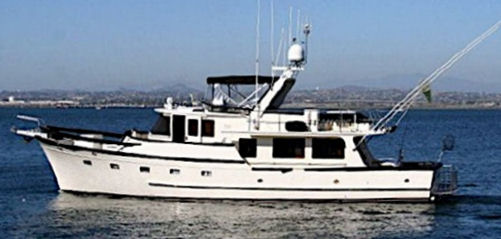
Lavish Use of Teak
Teak is more expensive than ever and that is why its use has been curtailed by many builders to one degree or another. Fleming buys teak logs, ages the wood, and does all of its own mill work. That is why on the Fleming 55 there is lots of hand-rubbed, satin-varnished teak in its interior. The tables, valances, entertainment center, and cabinetry are all teak. There are teak bulkheads. All interior decks are teak and holly, both on the main deck and in the accommodations.
Full Teak Deck
The cockpit, side decks, foredeck, stairs, and treads on the ladder going to the flying bridge, are all teak – as standard equipment. There are not many boats that offer that as standard. All teak decking is 5/8" thick, not the thinner option some builders use. The caprail around the boat's gunwales and Portuguese bridge are all varnished teak, though a low-maintenance caprail finished to look like teak is a popular choice.
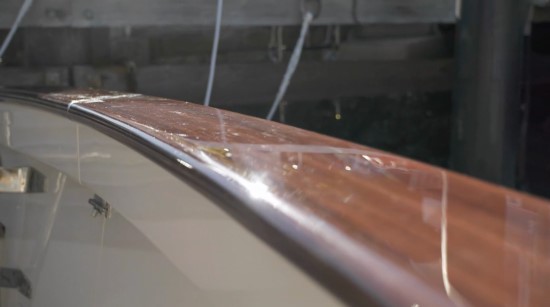
12V Battery on Flying Bridge
Most boats have house batteries in the engine room or a lazarette to keep weight low and so does Fleming. However, she also has a 12V “back-up” battery on the helm along with two Mastervolt 24V-to-12V DC/DC converters to provide emergency power for the radios in case the vessel is shipping water. This is rarely seen on any boat and is much appreciated.
Fleming 55 – Functionality and Seakeeping Details
Much of the spacious cockpit is not covered by the boat-deck overhang in the standard design, which allows sun chairs to be used in the cockpit for sunning or providing free movement for rods when fishing. A Bimini can be installed for those wanting shade. For those who want to change the profile of the yacht, an optional fiberglass extension to the boat deck above can be added to shelter the cockpit and allow for a canvas enclosure.

There are five hawsepipes on each side of the boat, plus two in the transom. In addition there are two 14” (35 cm) cleats on the bow and two in the stern on the bulwarks to make it easier to secure the boat in a variety of docking situations.

The hull of the Fleming 55 has an 8.5-degree deadrise at the transom. This is one of the secrets to her fuel efficiency at planing speeds. She is not a deep-V at the transom, which serves no real purpose in a displacement hull and makes the boat harder to push – and more prone to rolling at rest. A lower deadrise provides more lift when running and more stability when at rest or traveling at displacement speeds.
The hull shape features a rise of the vessel’s buttocks from a deeper point amidships. This design provides less drag at the transom and reduces wetted surface.
The keel protects the props, since it reaches 12” (30 cm) below them, preventing damage during a soft grounding. The vertical surface on this keel is greater than on most other boats in class. This helps keep her on track in a following sea, giving her directional stability.
The boat deck can handle a 12’ (3.96 m) tender, which is an adequate size for this boat, and a stainless steel cradle comes standard. The cradle can be removed when the dinghy is launched in order to use the boat deck for other purposes, such as placing sunlounges or an occasional table and chairs, so long as a guardrail is added. A Steelhead 1,000-pound (454 kg.) hydraulic davit comes standard, and uses a powered, telescoping boom.

Side gates make for easy boarding from docks of varying heights, and are located both port and starboard. Most boats in class do not have them.
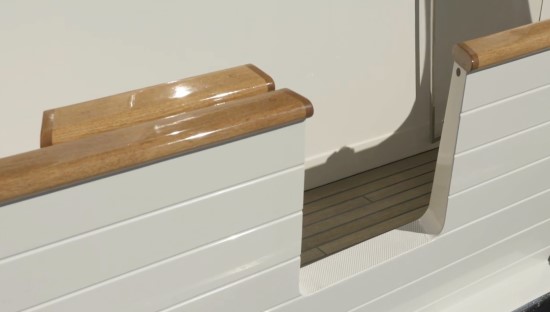
Fin stabilizers are optional on the Fleming 55 but provision has been made in the engine room for their installation. They are probably not needed unless long voyages are planned.
The fiberglass radar arch is standard, equipped with a stainless steel mast with navigation lights, anchor light, and aft-facing flood light. We like navigation lights positioned up high (instead of on the bow or even on the pilothouse) because they can be seen at a greater distance. There is LED lighting under the arch.
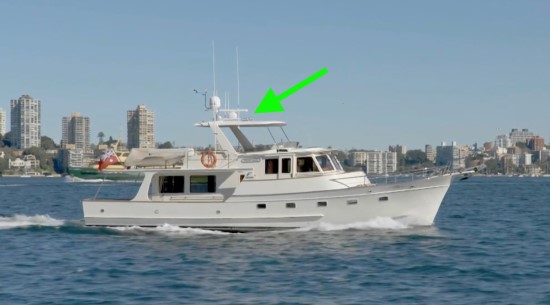
The pilothouse has sliding aluminum doors both port and starboard. These allow for easy egress by the captain or crew for docking or anchoring chores, but stay out of the way for crew passing on either side of the house.
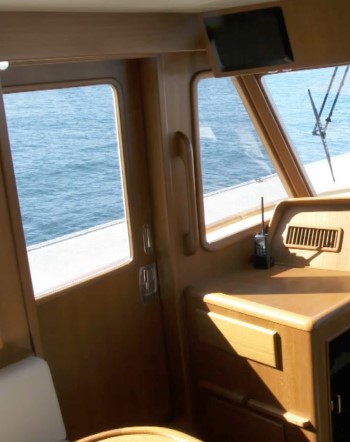
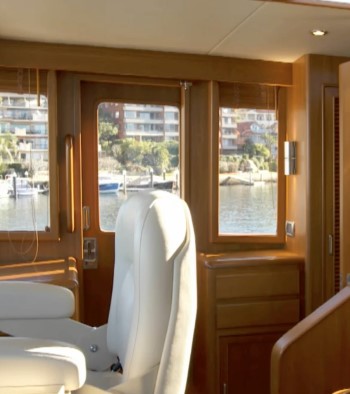
A comfortable L-shaped settee and teak table are located behind the helm and serve as an ideal place for guests to sit when running, or for light meals while underway. There are even built-in book shelves equipped with fiddles, something we see all over the boat.
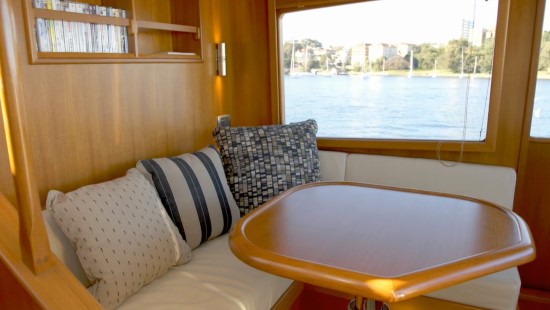
The Portuguese bridge provides security for crew and guests, and allows crew to cross the foredeck safely in sloppy conditions. It also protects the house if green water should be taken aboard. The side decks are 20” (50.8 cm) wide amidships and expand to 23” (58.4 cm) on the Portuguese bridge, which is three steps up. The bulwarks of the Portuguese bridge are 31 and 1/2” high on the centerline and double doors lead to the foredeck, with standard teak. This foredeck is both clean and unencumbered, making working here easy and safe. The large foredeck has bulwarks that are nearly 2’ (.61 m) high and rails that are 31” (.78 m) high. There are two 14” (.35 m) heavy-duty cleats on deck and four of the cleat/chocks combos in the bulwarks.
The Fleming 55’s engine room is accessed through a hatch in the cockpit just in front of the salon doors. Battery switches are right by the entrance of the engine room. Its overhead clearance is 4’4-1/2” (1.33 m) which sounds low, but our 5’11’ (1.80 m) 230-pound (104 kg) test captain reports that after moving around in it for a while, he got used to it. The key is in simply taking a seat when working on something.
The vessel can hook up to shore power anywhere in the world, thanks to an A/Sea frequency converter. This means the crew can connect the Fleming 55 to power without regard to voltage or Hertz frequency cycles, and it also protects the boat against power surges.

A 15.5-hp Side-Power Bow Thruster Comes as Standard Equipment. The hydraulics for the stabilizers and bow and stern thrusters are energized by the power take offs on each of the marine gears.
Deck scuppers drain water through pipes to the boot stripe so that black streaks will not appear on the hull sides.



Major Equipment
After the design and the layout, the most important category which gives a boat its utility is its list of equipment. Here are a few items that caught our eye:
Onan Generator
A 17 kW Onan generator is standard. It is mounted on soft mounts to reduce vibration. Onan is a division of Cummins, the builder that provides the main engines, making one-stop service possible. Cummins has service shops all over the world.
Sidepower Bow Thruster
A 15.5-hp Sidepower bow thruster is standard along with controls at both helm stations.
Lofrans Anchor Windlass
A 24V, 1700 Watt Lofrans Falkon windlass is fitted to the bow and has a plug-in control feature as well as remotes at both helm stations. This is a dual horizontal electric windlass equipped with both a Danforth-style and a standard 77-pound (35 kg) stainless steel Ultra anchor with chain hook, bridle, and 300’ (91.4 m) of high-test 3/8” (.95 cm) chain, with swivels between the anchor stock and the chain. On the port side of the pulpit are both fresh- and raw-water washdown bibs, and behind is a large hatch giving access to the rode locker, which has separate bins for chain and line. A nearby compartment contains the windlass remote.
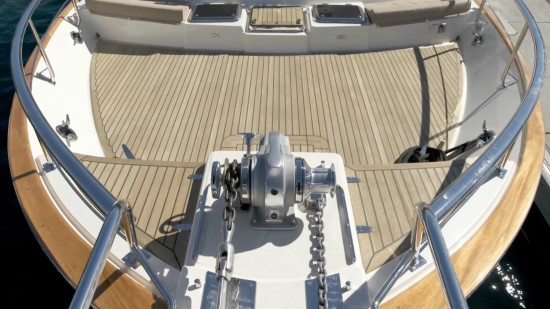
Complete Ground Tackle
This includes a 77-pound (35 kg) stainless steel Ultra anchor with ss Ultra swivel and 300' (91.4 m) of 3/8" (.95 cm) chain along with hook and bridle.
Cruisair Reverse-Cycle A/C
This system uses remote compressors (in the lazarette) and zone controls.
Kahlenberg Air Horn
With twin trumpets, this is the Mercedes of boat horns.
Auto Fire Suppression
This system automatically shuts down the engine, generator, and blowers in addition to spraying the fire suppression foam.
Stidd 500 XL Helm Seat
This brand is the Mercedes of helm seats (and costs nearly as much) and is mounted at the lower helm. We only wish there was a second one for the captain's companion.
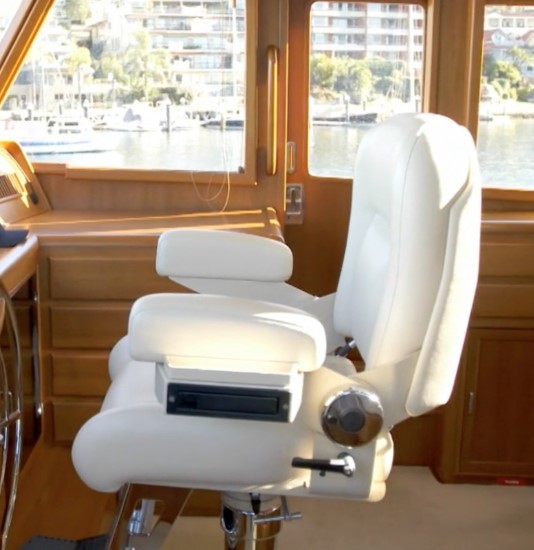
Fleming Monitoring System
The builder has made its own central monitoring system with color display screen. It Monitors navigation lights, tank levels, bilge water, engine room temperature, and engine room door, among other things.
Bosch Washer/Dryer
The dryer is vented and the unit is kept behind a sliding door in the passage by the guest stateroom where it is handy.

Headhunter Head
Many builders consider this brand of pressure jet toilet system to be the best in the industry.
Two Aluminum Helm Doors
One port and another starboard, both doors are sliders with weather stripping, and both allow the captain easy egress to the sidedecks for singlehanded sailing.
Steelhead Davit
All cruising boats need a tender and the Fleming 55 has room for a 13' (3.96 m) or larger one. The standard 1,000-pound (454 kg) Steelhead hydraulic davit has a telescoping neck.



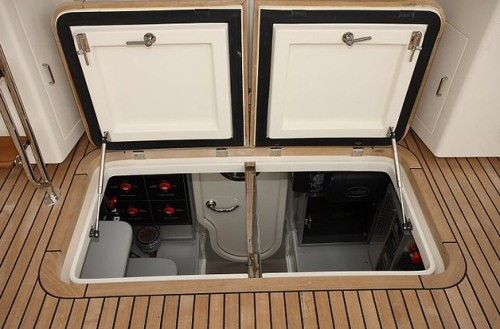
Comparing General Specs with Other Boats in Class
Criteria
We studied seven other cruising boats that came quickly to mind as falling into the same genre as the Fleming 55. We did not look at heavy-displacement, single-engine boats because they are in a class by themselves. But we did find two single-engine boats that met the genre criteria, from builders that claim that they can hit planing speeds. All were raised-pilothouse designs except one, which was flushdeck. Other criteria were a two- or three-stateroom layout and a fuel capacity of 800 gallon (3,028 L) or more.
LWL
When it comes to the crucial measurement of LWL, only two boats were longer, the others shorter by a foot. The foot is worth slightly over a knot in theoretical, easily-driven hull speed.
Displacement
In terms of displacement, the Fleming 55 falls in the middle at 74,000 lbs. (33,636 kg). Four were less, one was the same, and two were more.
Beam
The Fleming 55 has a 16’ (4.88 m) beam. Two of our comparison boats had a few inches less beam, a couple had a few inches more, and three had 21” (53 cm) or more.
Accommodations
Like the Fleming 55, most had three staterooms and two heads. A couple had two staterooms and two heads.
Main Deck
As noted above, the helm console and the aft deck of the Fleming are the largest. Most boats in class had only one helm side-deck egress door and a number had a larger table and seating area behind the helm. The galley and salon layouts are all about the same.

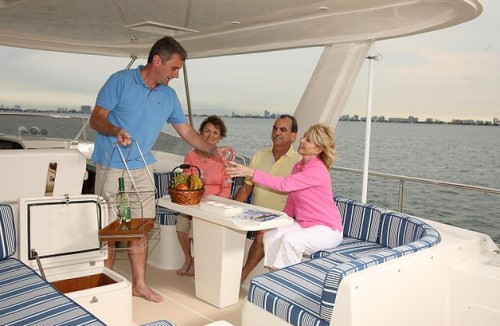
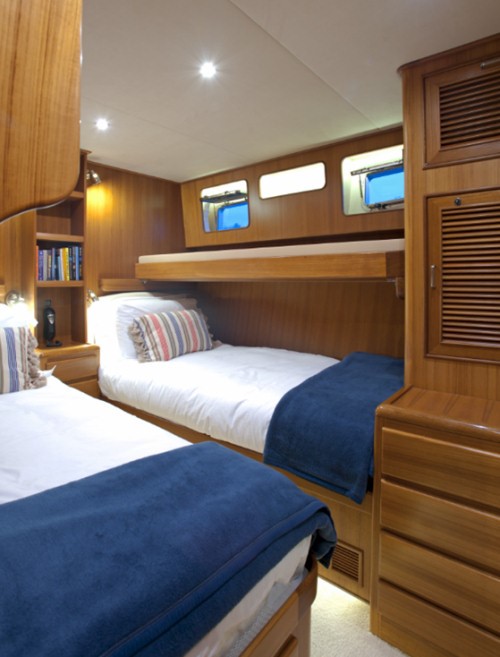

Features We Like
The thing that we like most about the Fleming 55 is that the builder is not trying to get the base price down by leaving essential equipment and gear off the boat that will only have to be added later. Further, the builder has added useful features that will be appreciated by experienced cruising folks. Here are some of those features in no particular order:
A dumb waiter from the galley to the flying bridge. This is something we've dreamed about for years but never did it. The Fleming 55 has one.
Two self-launching anchors and two rode lockers below, one for chain and one for line.
A watertight collision bulkhead between the forepeak and the forward cabin.
Fresh and saltwater washdown bibs on the foredeck and a hot and cold water shower in the cockpit.
A huge chart table at the helm with several drawers under for paper charts. This is the largest one in class.
The master berth lifts electrically with the touch of a button. Underneath is a good place to store items that are not used too often or only on special occasions.
The master berth also slides aft about a foot to simplify the process of making the berth, a smart touch that helps simplify keeping the master shipshape.
Shore power outlets in both the bow and stern means that extra cable is not needed when going into a slip either way. (We'd like to see a Cablemaster aboard as standard in the stern.)
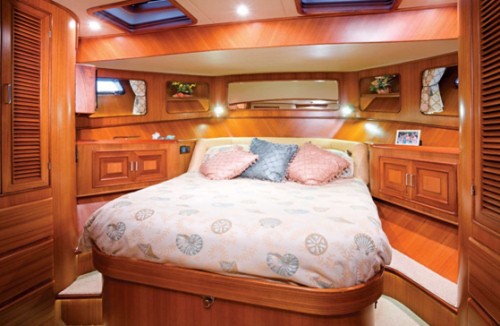
Galley and pantry windows slide open, bringing in fresh air.
All deck drains are piped to the boot stripe to prevent black streaks.
Stainless steel saddle for the yacht's tender cradle.
Fiberglass drip pans under the main engines.
LED lighting throughout the boat both in the interior, exterior, and for navigation lights.
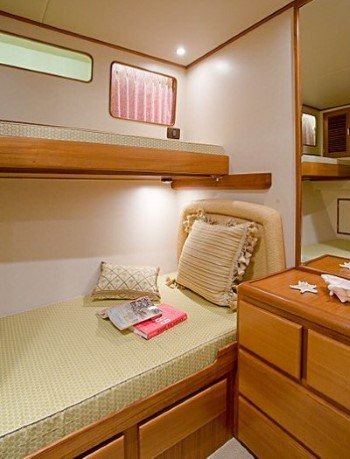

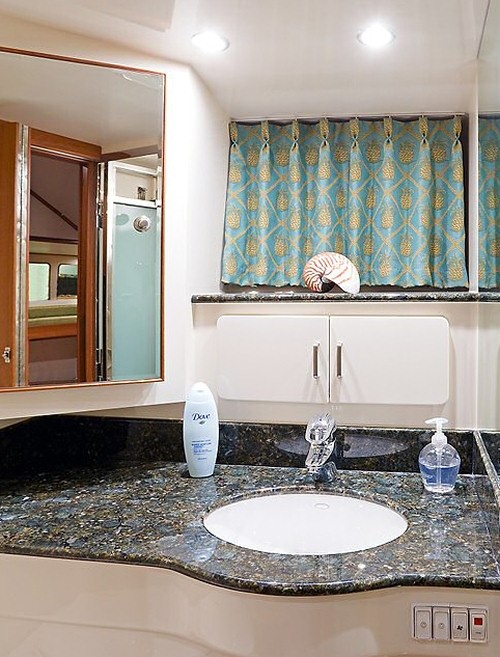
An icemaker in the salon entertainment console. This is a handy location to both the cockpit and salon.
All heads have ventilator fans, and while it seems sensible, we regret to have to mention this, but some yachts omit this little detail.
Sight glasses on all fuel and water tanks.
Either freshwater or sea water can be used to flush Headhunter toilets.
Ball-type seacocks are used on all thru-hull fittings at or below the waterline.
The whole boat is prewired for speakers with coax cable, CAT 5 cable, and 8-core signal cable.
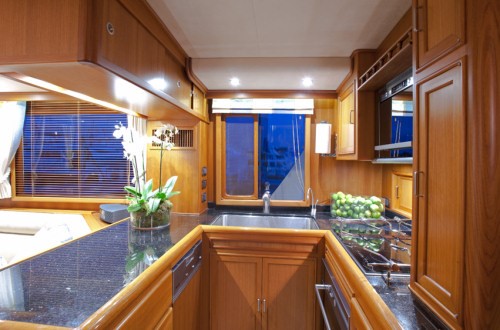
The Galley
A lot of thought — and experience — has gone into fine-tuning the galley for the preparation of 3-star meals aboard the Fleming 55. Owners may select granite or Corian countertops and backsplashes. As standard there is a deep, composite double sink and an "Inskinkerator" in one of the sinks to dispose of garbage. A convection microwave oven and three-burner ceramic electric cooktop with searails are installed for the cooking chores. We like the slide-out pantry locker with three shelves, making it easy to find and reach goods even in the back. A trash compactor is standard, but a dishwasher is not, although a space has been wired and plumbed for one. (We can't imagine not having a dishwasher aboard.)
Home-Style Refrigeration
What we like most about this galley is what is not actually in the U-shaped galley itself. To starboard, across the passageway from the salon to the helm, is a full-size, standup, 20.5 cu. ft. (.58 cu. m) refrigerator/freezer combination with two vertical swinging doors. The freezer is on the left side and the refrigerator is on the right. This is a name-brand household unit. This means there are no undercounter drawers that have to be pulled out into the tight galley space. The second thing we like is the dedicated dish locker on the starboard side that can be accessed either from the top (when offshore) or from the side (when tied up).

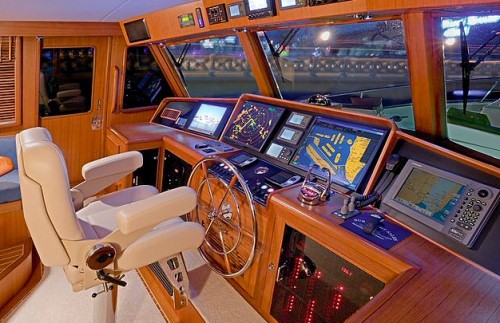
The Lower Helm
Virtually everything has been installed on the Fleming 55 except electronics. Most boaters we know go nuts on electronics and as much as we like redundancy in systems, we urge restraint on the more exotic gear. Fleming has provided plenty of instrument console space for four screens plus other readouts, including the Cummins VesselView screens. There is an overhead electronics console for those who have an open checkbook, but we suggest only installing units there that will be used infrequently, lest they become a pain in the neck — literally.
For any new boat we would recommend that boaters lay out the screens and instruments, and work with the boat dealer and electronics installer on where best to have everything placed. This is to say, we would not leave the layout of instruments, electronics and controls of all sorts to a third-party without very detailed consultation.
AC and DC panels are conveniently installed in the helm console down low. Plan on using a remote autopilot. Fleming has provided a defogging blower for the inside of the windshields and installed self-parking, heavy-duty multi-speed windshield wipers with freshwater wash.
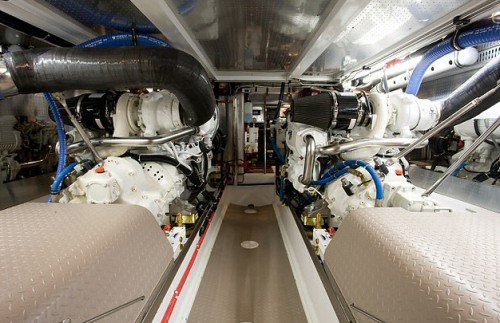
Power and Performance
The top speed we recorded was at 2640 rpm, producing 18.3 knots and 49.92 gallons per hour. While the Fleming 55 was not designed to go this fast, she can do it, and that speed could come in handy when racing a storm to port, or trying to make a tricky anchorage before nightfall.
Powered by 2 x Cummins QSC 8.3 L 500-HP
Top Speed on Our Test

Because this is a displacement vessel and not a planing one, there is no best cruise, per se, and the slower this boat goes the greater is its endurance. For the most part, people buying a Fleming 55 are not interested in how fast she goes, but how far she can go on a single load of fuel, and how much she burns per hour.
To calculate theoretical hull speed use this formula:
Square Root of LWL (50.83’) = 7.12 x 1.1 = 7.8 knots
When we use the theoretical hull speed formula and apply it to the Fleming 55, we get an easily driven hull speed of 7.8 knots. At 1000 rpm during our tests, she went 7.4 knots burning just 2.4 gallons per hour – and she would be nearly 50% more fuel efficient than when going 8.7 knots at 1250 rpm, and 10% faster.
Powered by 2x Cummins QSC 8.3 L 500-HP

In short, when she is in world-cruising mode, 7.4 knots might be a good speed to hold. More typically, however, 55 owners will want to go a little faster when doing coastal or near island work, when time is preferred over range. Then, they are likely to peg their total fuel consumption at 20, 30 or 40 liters per hour. In U.S. gallons, that equates to 5.3, 7.9, and 10.6 gallons per hour. At those fuel burns, our speed was 8.6, 9.7, and 10.1 knots, respectively. And, range – with a 10% fuel reserve – was 1,460 nm, 1,105 nm, and 858 nm.
Graphics--
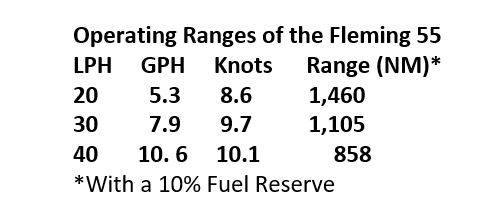

Price
The Fleming 55 is not cheap – her price in the U.S. is north of $2 million. As has been pointed out, the builder has simply put the best materials and equipment into the boat and has essentially let the chips fall where they may as far as price goes. The company has only four models and builds fewer than 20 yachts in total each year. The company’s owners are boatbuilders and not venture capitalists, so they have no interest in doubling or tripling the yard's production by having lower prices and skimping on quality to do it. In the words of one of the owners, “We want to build quality not quantity.” We believe him.
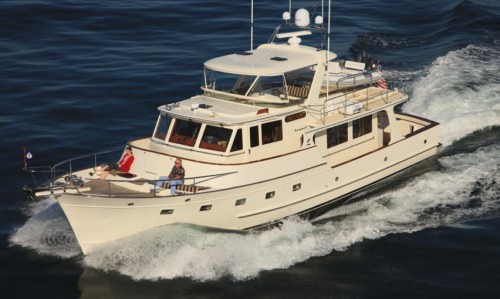
Observations
We would not recommend the Fleming 55 for everyone. People who just want a boat to bang around in local waters, or just go from marina to marina, or who only use the boat a few times each year – these people would probably be just as happy with a boat that costs much less. It is easily possible to buy too much boat for the work at hand, and the Fleming 55 is a good example of that. This is a boat that is designed and built for a connoisseur of fine yachts. The depth of experience that went into her lines and concept 27 years ago and the fact that she is essentially the same today (even though she has been re-tooled and dozens of little things have been changed), proves that she is a very special boat, indeed. She is an able vessel well-suited for many missions, and she will look good doing all of them.
